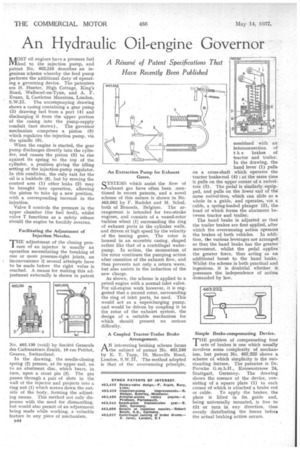An Hydraulic Oil-engine Governor
Page 54

If you've noticed an error in this article please click here to report it so we can fix it.
A Resume of Patent Specifications That Have Recently Been Published
MOST oil engines have a pressure fuel feed to the injection pump, and patent No. 463,310 describes an ingenious scheme whereby the feed pump performs the additional duty of operating a governing device. The patentees are H. Hunter, High Cottage, King's Road, Wallsend-on-Tyne, and A. F. Evans, 2, Castleton Mansions, London, S.W.13. The accompanying drawing shows a casing containing a gear pump (3) drawing fuel from a port (4) and discharging it from the upper portion of the casing into the pump-supply conduit (not shown).. The governor mechanism comprises a piston (8) which regulates the injection pump, via the spindle (9).
When the engine is started, the gear pump discharges directly into the cylinder, and causes the piston (8) to rise against its spring to the top of the cylinder, a position giving the idling setting of the injection-pump regulator. In this condition, the only exit for the oil is a leakhole (6), but by moving the control arm (1) other leaks (2) may be brought into operation, allowing the piston to take up a new position, with a corresponding increase in the injection.
Valve 5 controls the pressure in the upper chamber (for fuel feed), whilst valve 7 functions as a safety release should the engine be forcibly overrun.
Facilitating the Adjustment of Injection Nozzles.
THE adjustment of the closing pressure of an injector is usually an operation necessitating the breaking of one or more pressure-tight joints, an inconvenience if several attempts have to be made before the right value is reached. A means for making this adjustment externally is shown in patent
No. 463,130 (void) by Societ6 Generale des Carburateurs Zenith, 10 rue Petitot, Geneva, Switzerland.
In the drawing, the needle-closing spring (2) presses, at its upper end, on to an abutment disc, which bears, in turn, upon a stout pin (3). The pin passes through a pair of slots in the wall of the injector and projects into a ring nut (1) which screws down the outside of the body, forming the adjusting means. This method not only dispenses with the need for dismantling, but would also permit of an adjustment being made while working, a valuable feature in any piece of mechanism.
a44 An Extraction Pump for Exhaust Gases.
QYSTEMS which assist the flow of tJexhaust gas have often been, mentioned in recent patents, and a novel scheme of this nature is shown in No. 463,002 by F. Radelet and M. Schul, both of Brussels, Belgium, The arrangement is intended for two-stroke engines, and consists of a vaned-rotor turbine wheel (1) surrounding the ring of exhaust ports in the cylinder walls, and driven at high speed by the velocity of the issuing gases. The rotor is housed in an eccentric casing, shaped rather like that of a centrifugal waterpump. In action, the momentum of the rotor continues the pumping action after cessation of the exhaust flow, and thus prevents not only a return wave, but also assists in the induction of the new charge.
As shown, the scheme is applied to a petrol engine with a normal inlet valve. For oil-engine work however, it is suggested that a second rotor, surrounding the ring of inlet ports, be used. This would act as a supercharging pump, and would be driven by coupling it to the rotor of the exhaust system, the design of. a suitable mechanism for which should present no serious difficulty.
A Coupled Tractor-Trailer Brake Arrangement.
AA N intoresting braking scheme forms the subject of patent No. 463,249 by E. T. Tapp, 10, Manville Road, London, S,W.17. The method adopted is that of the overrunning principle,
combined with an interconnection of
t h e brakes of tractor and trailer. In the drawing, the hand lever (1)pulls on a cross-shaft which 'operates the tractor brake-rod (4) ; at the same time it pulls on the upper corner of a swiveltree (3). The pedal is similarly equipped, and pulls on the lower end of the' same swivel-tree, which can slide as a whole in a guide, and operates, via a cable, a spring-loaded plunger (2), the head of which forms the abutment between tractor and trailer.
The hand brake is adjusted so that the trailer brakes are first applied, after which the overrunning action operates the brakes of both vehicles. In addition, the various leverages are arranged. so that the hand brake has the greater movement, whilst the pedal applies the greater force, thus acting as an additional boost to the hand brake. Whilst the scheme is both practical and ingenious, it is doubtful whether it possesses the independence of action demanded by law.
Simple Brake-compensating Device.
T" problem of compensating four sets of brakes is one which usually involves some complexity of mechanism, but patent No. 463,222 shows a, scheme of which simplicity is the outstanding feature. The patentee is Dr. Porsche G.m.b.H., Kronenstrasse 24, Stuttgart, Germany. The drawing shows the essence of the device, consisting of a square plate (1) to each corner of which is attached a brake rod
or cable. To apply the brakes, the plate is lifted in its, guide and, being universally mounted, is free to tilt or turn in any direction, thus evenly distributing the forces before the actual braking action occurs.




















































































